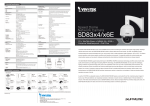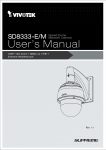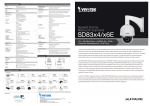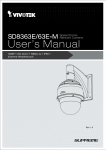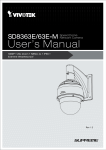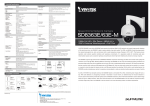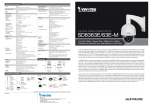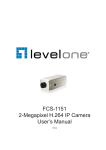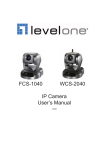Download User's Manual
Transcript
SD83x4E/83x6E Speed Dome Network Camera User’s Manual D1 • 18x or 36x Zoom • NEMA 4x • IP66 • Extreme Weatherproof Rev. 1.1 VIVOTEK Table of Contents Overview������������������������������������������������������������������������������������������������������������������������������������������������������4 Revision History��������������������������������������������������������������������������������������������������������������������������������������4 Read Before Use�������������������������������������������������������������������������������������������������������������������������������������5 Package Contents�����������������������������������������������������������������������������������������������������������������������������������5 Symbols and Statements in this Document���������������������������������������������������������������������������������������������5 Physical Description ����������������������������������������������������������������������������������������������� 6 Installation����������������������������������������������������������������������������������������������������������������������������������������������������9 Hardware Installation ����������������������������������������������������������������������������������������������������� 9 Network Deployment�����������������������������������������������������������������������������������������������������������������������������18 Software Installation������������������������������������������������������������������������������������������������������������������������������21 Ready to Use�����������������������������������������������������������������������������������������������������������������������������������������22 Accessing the Network Camera�����������������������������������������������������������������������������������������������������������������23 Using Web Browsers�����������������������������������������������������������������������������������������������������������������������������23 Using RTSP Players������������������������������������������������������������������������������������������������������������������������������25 Using 3GPP-compatible Mobile Devices�����������������������������������������������������������������������������������������������26 Using VIVOTEK Recording Software����������������������������������������������������������������������������������������������������27 Main Page��������������������������������������������������������������������������������������������������������������������������������������������������28 Client Settings��������������������������������������������������������������������������������������������������������������������������������������������34 Configuration����������������������������������������������������������������������������������������������������������������������������������������������39 System > General settings��������������������������������������������������������������������������������������������������������������������40 System > Homepage layout �����������������������������������������������������������������������������������������������������������������42 System > Logs �������������������������������������������������������������������������������������������������������������������������������������45 System > Parameters ���������������������������������������������������������������������������������������������������������������������������46 System > Maintenance��������������������������������������������������������������������������������������������������������������������������47 Media > Image �����������������������������������������������������������������������������������������������������������������������������������51 Media > Video���������������������������������������������������������������������������������������������������������������������������������������61 Media > Audio���������������������������������������������������������������������������������������������������������������������������������������65 Network > General settings�������������������������������������������������������������������������������������������������������������������66 Network > Streaming protocols �����������������������������������������������������������������������������������������������������������74 Network > DDNS ���������������������������������������������������������������������������������������������������������������������������������78 Network > SNMP (Simple Network Management Protocol)������������������������������������������������������������ 83 Security > User Account������������������������������������������������������������������������������������������������������������������������84 Security > HTTPS (Hypertext Transfer Protocol over SSL) ������������������������������������������������85 Security > Access List �������������������������������������������������������������������������������������������������������������������������92 PTZ > PTZ settings ������������������������������������������������������������������������������������������������������������������������������97 Event > Event settings �����������������������������������������������������������������������������������������������������������������������102 Applications > Motion detection���������������������������������������������������������������������������������������������������������� 116 Applications > DI and DO ������������������������������������������������������������������������������������������������������������������ 119 Applications > Audio detection ����������������������������������������������������������������������������������������������������������120 Applications > VADP (VIVOTEK Application Development Platform ��������������������������������������������������122 Recording > Recording settings ���������������������������������������������������������������������������������������������������������124 2 - User's Manual VIVOTEK Local storage > SD card management��������������������������������������������������������������������������������������������������������������� 129 Local storage > Content management��������������������������������������������������������������������������������������������������������������� 130 Appendix ���������������������������������������������������������������������������������������������������������������������������������������������������������������� 132 URL Commands for the Network Camera���������������������������������������������������������������������������������������������������������� 132 Technical Specifications������������������������������������������������������������������������������������������������������������������������������������� 220 Technology License Notice��������������������������������������������������������������������������������������������������������������������������������� 221 Electromagnetic Compatibility (EMC)����������������������������������������������������������������������������������������������������������������� 222 User's Manual - 3 VIVOTEK Overview VIVOTEK SD83x4E/x6E is a series of high performance day/night speed dome network cameras suitable for professional outdoor surveillance applications. The IP66-rated housing protects the camera body against rain and dust and the wide temperature range ensures operation under extreme weather conditions. It is especially suitable for monitoring wide open indoor/outdoor spaces such as airports, highways, and parking lots where high-level reliability and precision are always required. The SD83x4E/x6E support high-performance H.264/MPEG-4/MJPEG compression technology and offer extra smooth video quality up to 30 fps @ D1 Resolution. Boasting WDR Pro technology, the SD83x4E/x6E can also cope with challenging lighting conditions and generate image quality similar to the capabilities of a human eye. With sophisticated pan/tilt mechanism, the camera provides fast, precise movement with continuous 360-degree pan and 90-degree tilt. Users can easily control the lens position via a mouse or a joystick to track the object of interest and set up to 128 preset positions for patrolling. As with all VIVOTEK true day/night cameras, the SD83x4E/x6E feature removable IR-cut filter, maintaining clear images 24 hours a day. The built-in SD/SDHC card slot offers a convenient and portable storage option to prevent data loss in case of network disconnection. With other advanced features such as audio detection, 802.3at compliant PoE Plus and 30 fps high quality video, the SD83x4E/x6E are the best choices for the most demanding outdoor surveillance applications. Revision History ■ Rev. 1.0: Initial release ■ Rev. 1.2: Corrected and added a note about preset positions and the available positions for patrol. 4 - User's Manual VIVOTEK Read Before Use The use of surveillance devices may be prohibited by law in your country. The Network Camera is not only a high-performance web-ready camera but can also be part of a flexible surveillance system. It is the user’s responsibility to ensure that the operation of such devices is legal before installing this unit for its intended use. It is important to first verify that all contents received are complete according to the Package Contents listed below. Take note of the warnings in the Quick Installation Guide before the Network Camera is installed; then carefully read and follow the instructions in the Installation chapter to avoid damage due to faulty assembly and installation. This also ensures the product is used properly as intended. The Network Camera is a network device and its use should be straightforward for those who have basic networking knowledge. It is designed for various applications including video sharing, general security/ surveillance, etc. The Configuration chapter suggests ways to best utilize the Network Camera and ensure proper operations. For creative and professional developers, the URL Commands of the Network Camera section serves as a helpful reference to customizing existing homepages or integrating with the current web server. Package Contents ■ SD83x4E/83x6E ■ Wall Mount Bracket / Screws ■ Waterproof Connectors / Terminal Blocks / Ethernet Cable / Ground Wire ■ Screws / Alignment Sticker / T25 Stardriver / Seal Ring / Desiccant Bags ■ Quick Installation Guide ■ Software CD / Warranty Card ■ PC/ABS /Smoked Dome Cover / IO Combo Cable (Separately Purchased) Symbols and Statements in this Document i INFORMATION: provides important messages or advices that might help prevent inconvenient or problem situations. NOTE: Notices provide guidance or advices that are related to the functional integrity of the machine. Tips: Tips are useful information that helps enhance or facilitae an installation, function, or process. WARNING! or IMPORTANT!: These statements indicate situations that can be dangerous or hazardous to the machine or you. Electrical Hazard: This statement appears when high voltage electrical hazards might occur to an operator. User's Manual - 5 VIVOTEK Physical Description Outer View Reset Button Network LED Status LED Lens This drawing shows a camera with its dome cover removed. Inner View Camera Body Board-to-board Connector SD/SDHC/SDXC Card Slot The card slot is accessed by removing the top section using the T25 stardriver. 6 - User's Manual VIVOTEK Interface Section General I/O Terminal Block Ethernet Ethernet 10/100 RJ45 Plug AC24V AC24V Reserved MIC IN RS485RS485+ DI GND DI4 DI3 DI2 DI1 DO2 DO1 DO+(12V) Status LED Item LED status Description 1 Steady red Power on and system booting Red LED off Power off 2 Steady red & Green blinking every 1 sec. Network normal (heartbeat) Steady red & Green LED off Network failed 3 Red blinking every 0.15 sec. & Green blinking Upgrading firmware every 1 sec. 4 Red blinking every 0.15 sec. & Green blinking Restoring default every 0.15 sec. Hardware Reset The reset button is used to reset the system or to restore the factory default settings. Sometimes resetting the system can return the camera to normal operation. If the system problems remain after reset, restore the factory settings and install again. Reset: Press and release the recessed reset button with a paper clip or thin object. Wait for the Network Camera to reboot. Restore: Press and hold the recessed reset button for a while to restore. Note that all settings will be restored to factory default. SD/SDHC/SDXC Card Capacity This network camera is compliant with SD/SDHC/SDXC 32GB, 64GB, and other preceding standard SD cards. User's Manual - 7 VIVOTEK DI/DO Diagram Please refer to the following illustration for the connection method. Please note that the maximum load on the DO pins is 50mA. GND GND VDC Camera Power (DO+ 12V) Camera Power Input BJT transistor Switch +12 VDC Max. Output Input BJT transistor Relay VDC Switch +12 VDC Output Relay IMPORTANT: 1. The camera can be driven by an Ethernet connection to a PoE Plus switch (30W output). You can connect both the PoE Plus and the 24V power for fail-safe redundancy. 2. If the installation requires heating in the winter (<-5ºC), you will need approximately 60 Watts of power to drive the embedded heater. You can either connect the 24V power lines or a High Power PoE power injector (separately purchased). 8 - User's Manual VIVOTEK Installation Hardware Installation 1. Connecting RJ45 Ethernet Cable RJ45 Cable Dimension (unit: mm) Use CAT5e cables only. Components of the Waterproof Connector Sealing Nut (A) Seal (B) Screw Nut (C) Housing (D) Gasket (E) 100 Assembling Steps 1 Prepare an Ethernet cable and strip part of the sheath. 2 Insert the housing into the screw nut. (C) 3 (D) Insert the seal into the housing. (B) Recommended cable gauge: O.D. 5.5~7 4 Insert the stripped Ethernet cable through the sealing nut and the housing. 5 Clamp the cable with an RJ45 plug. 6 Push the RJ45 plug into the housing, then secure the sealing nut tightly. (A) 7 Attach the gasket to the front of the housing. 8 Connect the Ethernet cable to the RJ45 cable and secure the connectors tightly. (E) User's Manual - 9 VIVOTEK 2. Connecting Power and I/O Wires If you need to connect I/O wires and 24V power, disassemble the top section of the camera. It is highly recommended to complete the following before you can mount the speed dome camera at the installation site: Skip this section and move to Section 3-3 if you connect the Ethernet cable only. 1-3 1-1 1-2 Connect with the mount bracket Cabling through the dome cap and waterproof connectors Plan the wire length and complete cabling to the Interface Section 2-1. Cabling through the Waterproof Connectors Components of the Waterproof Connector Screw Nut (A) • Wire range: 13~16AWG (1.2~1.8mm) • A socket wrench for the M20 hex nut is required. Seal (B) Seals (C) Housing (D) Sealing Nut (E) 10 - User's Manual VIVOTEK 1. Disassemble the components of the waterproof connector into parts (A) ~ (E) as shown above. 2. Remove the plastic stopper from the bottom of the dome cap and keep the M20 hex nut for later use. 3. Depending on the number of wires, remove seals (C) from the rubber seal (B). 4. If you have external devices such as sensors and alarms, feed IO wires through the waterproof connector (E --> D --> B --> A) as the illustrated below. Note that there are 16 holes on the seal (B), and wire range is beteen 1.2 and 1.8mm. 5. Push the seal (B) into the housing (D). 6. Secure the sealing nut (E) tightly. (A) M20 hex nut (B) (D) (E) (C) (D) (B) 2-2. Connect cables: 1. Use a small-size flat-blade screwdriver to secure IO wires to the included terminal blocks. You may also purchase an IO combo cable from VIVOTEK. Ethernet AC24V AC24V Reserved MIC IN Line OUT Audio GND RS485RS485+ AC24V AC24V Reserved MIC IN Line OUT Audio GND RS485RS485+ Wire range: 13~16AWG Strip length: 6~7mm Screw: M2 DI GND DI4 DI3 DI2 DI1 DO2 DO1 DO+(12V) DI GND DI4 DI3 DI2 DI1 DO2 DO1 DO+(12V) User's Manual - 11 VIVOTEK 2.Feed the Ethernet cable and IO wires through the mounting bracket, the openings on the dome cap, and to the interface section. Attach the rubber seal plug to dome cap for water proofing. 3. Secure the included ground wire to the dome cap, pass it through the mount bracket, and connect the other end to a grounded conduit later. 2 Mount bracket 3 Dome cap Interface Section NOTE: 1. I/O wires are user-supplied. 2. Avoid touching the circuit boards to prevent damage by electro static discharge. 12 - User's Manual VIVOTEK 1-3. Connect with the Mount Bracket Combine the components of the top section. 1. Press the seal ring into the groove on the interface section. Use the black machine screws (M4x8) to attach the interface section to the dome cap. 2. Secure the dome cap to the mount bracket. 3. Use the included hex wrench to secure the connection. 3 2 Seal Ring 1 When done, the top section will look like this. You can now carry the camera and the top section to the installation site. Mount Bracket Interface Section Board-to-board Connector User's Manual - 13 VIVOTEK 2. Mounting the Network Camera Shown below are the dimensions of the wall mount bracket and its mounting holes: 3mm Hexagon Socket Headless Set Screw R5 107,8 140 ,2 53 R2 156 200 225,2 165,5 10 170,06 13,9 Cable Clamp 243,8 1-1/2" (PS11) 9 You can find the installation instructions on VIVOTEK’s website for other options such as a parapet mount: http://www.vivotek.com/web/ product/accessories.aspx 20 14 - User's Manual VIVOTEK IMPORTANT: You should examine whether the color of the silica gel inside the chassis has turned red. If so, you should replace the desiccant bag. To replace the desiccant bags: 1. Remove the dome cover by loosening 4 T25 anti-tamper screws. 2. Replace the desiccant bags by attaching them firmly to the inside of the chassis. 3. Re-install the dome cover. Note that it takes approximately 2 days to suppress the moisture level to 30% or lower. Before that, condensation may still be observed from on the dome cover. Pro HD WDR User's Manual - 15 VIVOTEK NOTE: Before mounting the camera, install an SD card if you prefer recording to local storage. 1. Mounting with Ethernet Connection Only 1. The camera weighs 3.66kg. Select a rigid mounting location to prevent vibration to the camera. Attach the alignment sticker to the wall. 2. Drill 4 pilot holes (10mm in diameter and 4cm deep) into the wall, and then hammer in threaded anchors. Note that you should hammer the anchors with hex nuts on them so that the threaded poles will not be deformed! If preferred, drill another hole for routing cables. 3. Secure the wall mount bracket to wall using 4 sets of captive washers and nuts. 4. Align the camera with the wall mount bracket. 5. Tighten 3 included screws using a Phillips screwdriver. Make sure all parts have been securely tightened. 2 3 1 4 5 HD 16 - User's Manual WDR Pro VIVOTEK 2. Mounting with Ethernet & I/O Wires 1. The camera weighs 3.66kg. Select a rigid mounting location to prevent vibration to the camera. Attach the alignment sticker to the wall. 2. Drill 4 pilot holes (10mm in diameter and 4cm deep) into the wall, and then hammer in threaded anchors. Note that you should hammer the anchors with hex nuts on them so that the threaded poles will not be deformed! If preferred, drill another hole for routing cables. 3. Secure the wall mount bracket to wall using 4 sets of captive washers and nuts. 4. Align the camera body with the top section. Align the alignment mark on the camera with that on the interface section. Push the camera up to match the top section. 5. Rotate the camera clockwise until its alignment mark is aligned with the "C" mark. 6. Use the included T25 stardriver to tighten the 3 anti-tamper screws from the top. Make sure all parts have been securely tightened. 2 3 4 1 HD WDR Pro 4 Alignment Mark 5 HD WDR 6 Pro C Mark HD WDR Pro User's Manual - 17 VIVOTEK Network Deployment Setting up the Network Camera over the Internet There are several ways to set up the Network Camera over the Internet. The first way is to set up the Network Camera behind a router. The second way is to utilize a static IP. The third way is to use PPPoE. Internet connection via a router Before setting up the Network Camera over the Internet, make sure you have a router and follow the steps below. 1. Connect your Network Camera behind a router, the Internet environment is illustrated below. Regarding how to obtain your IP address, please refer to Software Installation on page 21 for details. WAN (Wide Area Network ) Internet Router IP address : from ISP POWER COLLISION 1 2 3 4 5 IP address : 192.168.0.3 Subnet mask : 255.255.255.0 Default router : 192.168.0.1 LINK RECEIVE PARTITION LAN (Local Area Network) Router IP address : 192.168.0.1 Cable or DSL Modem IP address : 192.168.0.2 Subnet mask : 255.255.255.0 Default router : 192.168.0.1 2. In this case, if the Local Area Network (LAN) IP address of your Network Camera is 192.168.0.3, please forward the following ports for the Network Camera on the router. ■ Secondary HTTP port: 8080 ■ RTSP port: 554 ■ RTP port for audio: 5558 ■ RTCP port for audio: 5559 ■ RTP port for video: 5556 ■ RTCP port for video: 5557 If you have changed the port numbers on the Network page, please open the ports accordingly on your router. For information on how to forward ports on the router, please refer to your router’s user’s manual. 3. Find out the public IP address of your router provided by your ISP (Internet Service Provider). Use the public IP and the secondary HTTP port to access the Network Camera from the 18 - User's Manual VIVOTEK Internet. Please refer to Network Type on page 66 for details. For example, your router and IP settings may look like this: Device IP Address: internal IP Address: External Port (Mapped port on the port router) Public IP of router 122.146.57.120 LAN IP of router 192.168.2.1 Camera 1 192.168.2.10:80 122.146.57.120:8000 Camera 2 192.168.2.11:80 122.146.57.120:8001 ... ... ... Configure the router, virtual server or firewall, so that the router can forward any data coming into a preconfigured port number to a network camera on the private network, and allow data from the camera to be transmitted to the outside of the network over the same path. From Forward to 122.146.57.120:8000 192.168.2.10:80 122.146.57.120:8001 192.168.2.11:80 ... ... When properly configured, you can access a camera behind the router using the HTTP request as follows: http://122.146.57.120:8000 If you change the port numbers on the Network configuration page, please open the ports accordingly on your router. For example, you can open a management session with your router to configure access through the router to the camera within your local network. Please consult your network administrator for router configuration if you have troubles with the configuration. For more information with network configuration options (such as that of streaming ports), please refer to Configuration > Network Settings. VIVOTEK also provides the automatic port forwarding feature as an NAT traversal function with the precondition that your router must support the UPnP port forwarding feature. User's Manual - 19 VIVOTEK Internet connection with static IP Choose this connection type if you are required to use a static IP for the Network Camera. Please refer to LAN on page 66 for details. Internet connection via PPPoE (Point-to-Point over Ethernet) Choose this connection type if you are connected to the Internet via a DSL Line. Please refer to PPPoE on page 67 for details. General Connection 1. Connect the Network Camera's Ethernet cable (CAT5e) to a PoE Plus switch. A 30W PoE output port alone can not drive the onboard heater, and hence if using the PoE switch alone, the application does not apply in low-temperature condition. 30W PoE plus can only drive the camera when it is working at a temperature higher than -5ºC. 2. Connect the power wires to an AC 24V power adaptor (user-supplied). The AC 24V adapter can drive the camera and the onboard heater. You can connect both power sources for redundancy in power supply. IEEE 802.3at PoE Switch (30W output) and / or HD WDR Pro AC 24V 3.5A Adapter (User-supplied) Power over Ethernet (High Power PoE) When using a non-PoE switch Use a High Power PoE power injector (separately purchased) capable of 60W output to connect between the Network Camera and a non-PoE switch. Sufficient power is required for low temperature conditions when the onboard heater is activated. HD WDR Pro High Power PoE Power Injector Non-PoE Switch 20 - User's Manual VIVOTEK Software Installation Installation Wizard 2 (IW2), free-bundled software included on the product CD, helps you set up your Network Camera on the LAN. 1. Install IW2 under the Software Utility directory from the software CD. Double click the IW2 shortcut on your desktop to launch the program. IW2 Installation Wizard 2 2. The program will conduct an analysis of your network environment. After your network environment is analyzed, please click Next to continue the program. 3. The program will search for all VIVOTEK network devices on the same LAN. 4. After a brief search, the main installer window will prompt. Double-click on the MAC and model name which matches the product label on your device to connect to the Network Camera via a web browser. Network Camera Model No: SD83x4E R o HS MAC:0002D1730202 This device complies with part 15 of the FCC rules. Operation is subject to the following two conditions: (1)This device may not cause harmful interference, and (2) this device must accept any interference received, including interference that may cause undesired operation. Pat. 6,930,709 Made in Taiwan 00-02-D1-73-02-02 192.168.5.151 SD83x4E 0002D1730202 User's Manual - 21 VIVOTEK Ready to Use 1. A browser session with the Network Camera should prompt as shown below. 2. You should be able to see live video from your camera. You may also install the 32-channel recording software from the software CD in a deployment consisting of multiple cameras. For its installation details, please refer to its related documents. 18x IMPORTANT: • Currently the Network Camera utilizes a 32-bit ActiveX plugin. You CAN NOT open a management/view session with the camera using a 64-bit IE browser. • If you encounter this problem, try execute the Iexplore.exe program from C:\Windows\ SysWOW64. A 32-bit version of IE browser will be installed. • On Windows 7, the 32-bit explorer browser can be accessed from here: C:\Program Files (x86)\Internet Explorer\iexplore.exe • If you experience compatibility issues between the plug-in control, you may try to uninstall the Camera Stream Controller located in: C:/Program Files (x86)/Camera Stream Controller. 22 - User's Manual VIVOTEK Accessing the Network Camera This chapter explains how to access the Network Camera through web browsers, RTSP players, 3GPP-compatible mobile devices, and VIVOTEK recording software. Using Web Browsers Use Installation Wizard 2 (IW2) to access to the Network Cameras on the LAN. If your network environment is not a LAN, follow these steps to access the Netwotk Camera: 1. Launch your web browser (e.g., Microsoft® Internet Explorer or Mozilla Firefox). 2. Enter the IP address of the Network Camera in the address field. (A temporary IP will be generated for the camera. Find it in your Network Neighborhood). Press Enter. 3. Live video will display in your web browser. 4. If it is the first time installing the VIVOTEK network camera, an information bar will pop up as shown below. Follow the instructions to install the required plug-in on your computer. 28x NOTE: For Mozilla Firefox or Netscape users, your browser will use Quick Time to stream live video. If you do not have Quick Time on your computer, please download Quick Time from Apple Inc's website, and then launch your web browser. 28x 28x User's Manual - 23 VIVOTEK ► By default, the Network Camera is not password-protected. To prevent unauthorized access, it is highly recommended to set a password for the Network Camera. For more information about how to enable password protection, please refer to Security on page 84. ► If you see a dialog box indicating that your security settings prohibit running ActiveX ® Controls, please enable the ActiveX ® Controls for your browser. 1. Choose Tools > Internet Options > Security > Custom Level. 2. Look for Download signed ActiveX ® controls; select Enable or Prompt. Click OK. 3. Refresh your web browser, then install the ActiveX ® control. Follow the instructions to complete installation. 24 - User's Manual VIVOTEK Using RTSP Players To view the H.264/MPEG-4 streaming media using RTSP players, you can use one of the following players that support RTSP streaming. Quick Time Player VLC Media Player VLCthe media player 1. Launch RTSP player. 2. Choose File > Open mpegable PlayerURL. An URL dialog box will pop up. 3. The address format is rtsp://<ip address>:<rtsp port>/<RTSP streaming access name for pvPlayer stream1 or stream2> As most ISPs and players only allow RTSP streaming through port number 554, please set the RTSP port to 554. For more information, please refer to RTSP Streaming on page 75. For example: rtsp://192.168.5.151:554/live.sdp 4. The live video will be displayed in your player. For more information on how to configure the RTSP access name, please refer to RTSP Streaming on page 75 for details. Video 16:38:01 2011/03/25 User's Manual - 25 VIVOTEK Using 3GPP-compatible Mobile Devices To view the streaming media through 3GPP-compatible mobile devices, make sure the Network Camera can be accessed over the Internet. For more information on how to set up the Network Camera over the Internet, please refer to Setup the Network Camera over the Internet on page 18. To utilize this feature, please check the following settings on your Network Camera: 1. Because most players on 3GPP mobile phones do not support RTSP authentication, make sure the authentication mode of RTSP streaming is set to disable. For more information, please refer to RTSP Streaming on page 75. 2. As the the bandwidth on 3G networks is limited, you will not be able to use a large video size. Please set the video and audio streaming parameters as listed below. For more information, please refer to Stream settings on page 62. Video Mode Frame size Maximum frame rate Intra frame period Video quality (Constant bit rate) Audio type (GSM-AMR) MPEG-4 176 x 144 5 fps 1S 40kbps 12.2kbps 3. As most ISPs and players only allow RTSP streaming through port number 554, please set the RTSP port to 554. For more information, please refer to RTSP Streaming on page 75. 4. Launch the player on the 3GPP-compatible mobile devices (ex. Real Player). 5. Type the following URL commands into the player. The address format is rtsp://<public ip address of your camera>:<rtsp port>/<RTSP streaming access name for stream 3>. For example: rtsp://192.168.5.151:554/live.sdp 26 - User's Manual VIVOTEK Using VIVOTEK Recording Software The product software CD also contains recording software, allowing simultaneous monitoring and video recording for multiple Network Cameras. Please install the recording software; then launch the program to add the Network Camera to the Channel list. For detailed information about how to use the recording software, please refer to the user’s manual of the software or download it from http://www.vivotek.com. User's Manual - 27 VIVOTEK Main Page This chapter explains the layout of the main page. It is composed of the following sections: VIVOTEK INC. Logo, Host Name, Camera Control Area, Configuration Area, and Live Video Window. VIVOTEK INC. Logo Resize Buttons Host Name 36x Configuration Area Camera Control Area Hide Button Live View Window Mouse and Screen Control In addition to the use of a joystick, mouse control is also supported by the web session. You can click on any spot on the screen to move camera's field of view to that direction. To pan 360 degrees, you can click and hold down the left mouse button when clicking a PTZ directional button. The same applies to arrow keys, Zoom, and Focus buttons on the PTZ panel. 36x Click and hold down the button Zoom In Zoom Out Click to bring to center of view Note that if your screen control malfunctions, it is possible that the CPU of your current view station can not cope with the HD video feeds or that an incompatibility issue occurred with the ActiveX control plugins. 28 - User's Manual VIVOTEK VIVOTEK INC. Logo Click this logo to visit the VIVOTEK website. Host Name The host name can be customized to fit your needs. For more information, please refer to System on page 40. Camera Control Area Video Stream: This Network Camera supports multiple streams (stream 1 ~ 4) simultaneously. You can select either one for live viewing. For more information about multiple streams, please refer to page 63 for detailed information. Manual triggers: Manual triggers can be turned on/off by users from the main page. The manual triggers can be associated with the Event settings, and, as the result, can be used to perform recording actions, sending notifications, and so on. See Event settings on page 102. Digital Output: Click to turn the digital output device on or off. PTZ Control Panel: Up Return to Home Position Right Left Down Zoom Out Focus Near Start to Auto Pan Zoom In Auto Focus Focus Far Auto Tracking Start to Auto Patrol Stop Auto Panning/patrolling Pan: Click this button to start the auto pan (360° continuous rotation). Stop: Click this button to stop the Auto Pan, Auto Patrol, and Auto Tracking functions. Patrol: Once the Administrator has determined the list of preset positions (including the zoom-in action on a particular position), click this button to command the camera to patrol among those positions on the Patrol List. The Network Camera will patrol continuously. For more information, please refer to PTZ control on page 97. Track: Allows the camera to move along following the moving objects in the current field of view. If you observe an object of your interest, click this button to track the object. Note that this function does not apply in an extremely crowded area, such as a market or sidewalk full of pedestrian activities. Constant shift of tracked objects will decrease the usability of this feature. Once started, you can use the Stop button to stop the current action. A click on the screen can also stop the tracking action. Another key concept is that the camera only detect movements within the current field of view. Please refer to PTZ > Auto tracking on page 100 and further for tracking configuration details. User's Manual - 29 VIVOTEK Pan /Tilt /Zoom /Focus speed: Adjust the speed of Pan/ Tilt/ Zoom/ Focus: Pan speed Tilt speed Zoom speed Focus speed -5 -5 -5 -5 -4 -4 -4 -4 -3 -3 -3 -3 -2 -2 -2 -2 -1 -1 -1 -1 0 0 0 0 1 1 1 1 2 2 2 2 3 3 3 3 4 4 4 4 5 5 5 5 Slower Faster Note that mouse screen control is also supported. You can refer to page 97 for related information. Configuration Area Client Settings: Click this button to access the client setting page. For more information, please refer to Client Settings on page 34. Configuration: Click this button to access the configuration page of the Network Camera. It is suggested that a password be applied to the Network Camera so that only the administrator can configure the Network Camera. For more information, please refer to Configuration on page 39. Language: Click this button to choose a language for the user interface. Language options are available in: English, Deutsch, Español, Français, Italiano, 日本語, Português, 簡体中文, and 繁體中文. You can also change a language on the Configuration page; please refer to page 39. Hide Button You can click the hide button to hide the control panel or display the control panel. 30 - User's Manual VIVOTEK Resize Buttons : Click the Auto button, the video cell will resize automatically to fit the monitor. Click 100% is to display the original homepage size. Click 50% is to resize the homepage to 50% of its original size. Click 25% is to resize the homepage to 25% of its original size. Go to If you have preset PTZ positions, these positions will be available in the Go to menu. Please refer to page 97 for more information. Live Video Window ■ The following window is displayed when the video mode is set to H.264 / SVC / MPEG-4: H.264/MPEG-4 Protocol and Media Options Video Title Title and Time Time 2013/03/10 17:08:56 Video (TPC-AV) Video 17:08:56 2013/03/10 Video and Audio Control Buttons Video Title: The video title can be configured. For more information, please refer to Video settings on page 51. H.264 / MPEG-4 Protocol and Media Options: The transmission protocol and media options for H.264 / MPEG-4 video streaming. For further configuration, please refer to Client Settings on page 34. Time: Display the current time. For further configuration, please refer to Media > Image > General settings on page 51. Title and Time: The video title and time can be stamped on the streaming video. For further configuration, please refer to Media > Image > General settings on page 51. The zoom ratio is also displayed with the title bar. 2.0x Title 2013/09/05 10:39:08 Video and Audio Control Buttons: Depending on the Network Camera model and Network Camera configuration, some buttons may not be available. Frame rate level: The Frame rate level menu is available when you configure your video stream as the MJPEG or SVC mode. The frame rate menu allows you to manually select a frame rate for the current video stream. Please refer to page 63 for more information. User's Manual - 31 VIVOTEK Snapshot: Click this button to capture and save still images. The captured images will be displayed in a pop-up window. Right-click the image and choose Save Picture As to save it in JPEG (*.jpg) or BMP (*.bmp) format. Digital Zoom: Click and uncheck “Disable digital zoom” to enable the zoom operation. The navigation screen indicates the part of the image being magnified. To control the zoom level, drag the slider bar. To move to a different area you want to magnify, drag the navigation screen. Pause: Pause the transmission of the streaming media. The button becomes the after clicking the Pause button. Stop: Stop the transmission of the streaming media. Click the transmission. Resume button Resume button to continue Start MP4 Recording: Click this button to record video clips in MP4 file format to your computer. Stop MP4 Recording button to end recording. When you exit the web browser, video Press the recording stops accordingly. To specify the storage destination and file name, please refer to MP4 Saving Options on page 35 for details. Volume: When the local computer. Mute function is not activated, move the slider bar to adjust the volume on the Mute: Turn off the volume on the local computer. The button becomes the clicking the Mute button. Audio On button after Talk: Click this button to talk to people around the Network Camera. Audio will project from again to end talking the external speaker connected to the Network Camera. Click this button transmission. Mic Volume: When the Mute function is not activated, move the slider bar to adjust the microphone volume on the local computer. Mute: Turn off the Mic volume on the local computer. The button becomes the after clicking the Mute button. Mic On button Full Screen: Click this button to switch to full screen mode. Press the “Esc” key to switch back to normal mode. 32 - User's Manual VIVOTEK ■ The following window is displayed when the video mode is set to MJPEG: Video Title Title and Time Video (HTTP-V) 2013/03/10 17:08:56 Time Video 17:08:56 2013/03/10 Video Control Buttons Video Title: The video title can be configured. For more information, please refer to Media > Image on page 51. Time: Display the current time. For more information, please refer to Media > Image on page 51. Title and Time: Video title and time can be stamped on the streaming video. For more information, please refer to Media > Image on page 51. Video and Audio Control Buttons: Depending on the Network Camera model and Network Camera configuration, some buttons may not be available. Snapshot: Click this button to capture and save still images. The captured images will be displayed in a pop-up window. Right-click the image and choose Save Picture As to save it in JPEG (*.jpg) or BMP (*.bmp) format. Digital Zoom: Click and uncheck “Disable digital zoom” to enable the zoom operation. The navigation screen indicates the part of the image being magnified. To control the zoom level, drag the slider bar. To move to a different area you want to magnify, drag the navigation screen. Start MP4 Recording: Click this button to record video clips in MP4 file format to your computer. Stop MP4 Recording button to end recording. When you exit the web browser, video Press the recording stops accordingly. To specify the storage destination and file name, please refer to MP4 Saving Options on page 35 for details. Full Screen: Click this button to switch to full screen mode. Press the “Esc” key to switch back to normal mode. User's Manual - 33 VIVOTEK Client Settings This chapter explains how to select the stream transmission mode and saving options on the local computer. When completed with the settings on this page, click Save on the page bottom to enable the settings. H.264 / MPEG-4 Media Options H.264/MPEG-4 Media Options Select to stream video or audio data or both. This is enabled only when the video mode is set to H.264 or MPEG-4. H.264 / MPEG-4 Protocol Options H.264/MPEG-4 Protocol Options Depending on your network environment, there are four transmission modes of H.264 or MPEG-4 streaming: UDP unicast: This protocol allows for more real-time audio and video streams. However, network packets may be lost due to network burst traffic and images may be broken. Activate UDP connection when occasions require time-sensitive responses and the video quality is less important. Note that each unicast client connecting to the server takes up additional bandwidth and the Network Camera allows up to ten simultaneous accesses. UDP multicast: This protocol allows multicast-enabled routers to forward network packets to all clients requesting streaming media. This helps reduce the network transmission load of the Network Camera while serving multiple clients at the same time. Note that to utilize this feature, the Network Camera must be configured to enable multicast streaming at the same time. For more information, please refer to RTSP Streaming on page 76. TCP: This protocol guarantees the complete delivery of streaming data and thus provides better video quality. The downside of this protocol is that its real-time effect is not as good as that of the UDP protocol. HTTP: This protocol allows the same quality as TCP protocol without needing to open specific ports for streaming under some network environments. Users inside a firewall can utilize this protocol to allow streaming data through. 34 - User's Manual VIVOTEK Two way audio Select an audio communication mode. In half-duplex mode, only one of the communicating sides can deliver audio. In full-duplex mode, make sure your client has embedded codec of sound card supporting the full-duplex function. MP4 Saving Options Users can record live video as they are watching it by clicking the button - Start MP4 Recording - on the main page. Here, you can specify the storage destination and file name. Folder: Specify a storage destination for the recorded video files. File name prefix: Enter the text that will be appended to the front of the video file name. Add date and time suffix to the file name: Select this option to append the date and time to the end of the file name of the recorded videos. CLIP_20130328-180853 File name prefix Date and time suffix The format is: YYYYMMDD_HHMMSS Local Streaming Buffer Time In a busy network, fluctuations in available bandwidth can occur. Video streaming may lag and may not proceed very smoothly. If you enable this option, video streams from the camera will be temporarily stored on the computer’s cache memory for a configurable period of time (seconds or milliseconds) before being played on a web session. This will help you see the streaming more smoothly. If you enter 3,000 Millisecond, the streaming will delay for 3 seconds. User's Manual - 35 VIVOTEK Joystick Settings Enable Joystick Connect to the USB plug of the joystick to a USB port on your management computer. Once a USB joystick is connected, the related joystick configuration will be available on the Client settings window. The joystick should work properly without installing any other driver or software. Then you can begin to configure the joystick settings of connected devices. Please follow the instructions below to enable joystick settings. 1. Click on the Configure buttons button. If your joystick is working properly, it will be displayed on the drop-down list. 36 - User's Manual VIVOTEK Buttons Configuration In the Joystick Settings window, you can use the combinations of pull-down menus, Actions and Button number, to assign joystick buttons with different functions. The number of buttons may differ from the joystick you attached. Please follow the steps below to configure your joystick buttons: 1. Select the number of the button you want to configure from its pull-down list. For example: Assign Preset 1 (move to preset 1 position) to Button 1. 2. Select an action from the Actions menu. Click Assign to associate the button with an action. 3. Your configuration will be automatically saved. 4. To disable an assignment, select the number of a button, and then click the Delete button. The associated action will then be cleared. 5. Repeat the above process to assign actions to other buttons. When done, simply close the configuration window. User's Manual - 37 VIVOTEK NOTE: • • If you want to assign Preset actions to your joystick, the PTZ preset locations should be configured in advance. If your joystick is not working properly, it may need to be calibrated. Click the Calibrate button to open the Game Controllers window located in Microsoft Windows control panel and follow the instructions for trouble shooting. • The joystick will appear in the Game Controllers list in the Windows Control panel. If you want to check out for your devices, go to the following page: Start -> Control Panel -> Game Controllers. • Follow the onscreen instructions to calibrate your joystick. 38 - User's Manual VIVOTEK Configuration Click Configuration on the main page to enter the camera setting pages. Note that only Administrators can access the configuration page. Please refer to page 84 Security > User Account for how to configure access rights for different users. VIVOTEK offers an easy-to-use user interface that helps you set up your network camera with minimal effort. To simplify the setting procedure, two types of user interfaces are available: Advanced Mode for professional users and Basic Mode for entry-level users. Some advanced functions (PTZ/ Event/ Recording/ Local storage) are not displayed in Basic Mode. If you want to set up advanced functions, please click [Advanced Mode] on the bottom of the configuration list to quickly switch to Advanced Mode. In order to simplify the user interface, the detailed information will be hidden unless you click on the function item. When you click on the first sub-item, the detailed information for the first subitem will be displayed; when you click on the second sub-item, the detailed information for the second sub-item will be displayed and that of the first sub-item will be hidden. Show below are the locations of the Basic Mode and the Advanced Mode screen elements: Basic Mode Navigation Area 20x Configuration List Click to switch to Advanced Mode Firmware Version User's Manual - 39 VIVOTEK Advanced Mode Navigation Area 20x Configuration List Click to switch to Basic Mode Firmware Version Each function on the configuration list will be explained in the following sections. Those functions that are displayed only in Advanced Mode are tagged with Advanced Mode . If you want to configure advanced functions, please click [Advanced Mode] on the bottom of the configuration list to quickly switch over. Navigation Area provides an instant switch among Home page (the monitoring page for live viewing), Configuration page, and multi-language selection. System > General settings This section explains how to configure the basic settings for the Network Camera, such as the host name and system time. It is composed of the following two columns: System and System Time. System Host name: Enter a desired name for the Network Camera. The text will be displayed at the top of the main page. 40 - User's Manual VIVOTEK System time Keep current date and time: Select this option to preserve the current date and time of the Network Camera. The Network Camera’s internal real-time clock maintains the date and time even when the power of the system is turned off. Synchronize with computer time: Select this option to synchronize the date and time of the Network Camera with the local computer. The read-only date and time of the PC is displayed as updated. Manual: The administrator can enter the date and time manually. Note that the date and time format are [yyyy/mm/dd] and [hh:mm:ss]. Automatic: The Network Time Protocol is a protocol which synchronizes computer clocks by periodically querying an NTP Server. NTP server: Assign the IP address or domain name of an established time server. Leaving the text box blank connects the Network Camera to the default time servers. The precondition is that your camera must have access to the Internet. Update interval: Select to update the time using the NTP server on an hourly, daily, weekly, or monthly basis. Time zone Advanced Mode : Select the appropriate time zone from the list. If you want to upload Daylight Savings Time rules, please refer to System > Maintenance > Import/ Export files on page 48 for details. When finished with the settings on this page, click Save at the bottom of the page to enable the settings. User's Manual - 41 VIVOTEK System > Homepage layout Advanced Mode This section explains how to set up your own customized homepage layout. General settings This column shows the settings of your hompage layout. You can manually select the background and font colors in Theme Options (the second tab on this page). The settings will be displayed automatically in this Preview field. The following shows the homepage using the default settings: ■ Hide Powered by VIVOTEK: If you check this item, such wording will be removed from the homepage. Logo graph Here you can change the logo at the top of your homepage. Follow the steps below to upload a new logo: 1. Click Custom and the Browse field will appear. 2. Select a logo from your files. 3. Click Upload to replace the existing logo with a new one. 4. Enter a website link if necessary. 5. Click Save to enable the settings. Customized button Deselect the checkbox if you do not need the Manual trigger buttons on the main page. 42 - User's Manual VIVOTEK Theme Options Here you can change the color of your homepage layout. There are three types of preset patterns for you to choose from. The new layout will simultaneously appear in the Preview filed. Click Save to enable the settings. Font Color of the Video Title Font Color Background Color of the Control Area Font Color of the Configuration Area Background Color of the Configuration Area Background Color of the Video Area Frame Color Preset patterns User's Manual - 43 VIVOTEK ■ Follow the steps below to set up the customed homepage: 1. Click Custom on the left column. 2. A double-click on the color selection area (the right hand side column) will bring up a color palette window. Color Selector Custom Pattern 3. The palette window will pop up as shown below. 2 3 1 4 4. Drag the slider bar and click on the left square to select a desired color. 5. The selected color will be displayed in the corresponding fields and in the Preview column. 6. Click Save to enable the settings. Below are options for system integrators or VARs. You can use the checkboxes to replace VIVOTEK’s company logo, the embedded website address or the slogan “Powered by VIVOTEK.“ When done, use the Save button to complete the configuration. 44 - User's Manual VIVOTEK System > Logs Advanced Mode This section explains how to configure the Network Camera to send the system log to the remote server as backup. Log server settings Follow the steps below to set up the remote log: 1. Select Enable remote log. 2. In the IP address text box, enter the IP address of the remote server. 2. In the port text box, enter the port number of the remote server. 3. When completed, click Save to enable the setting. You can configure the Network Camera to send the system log file to a remote server as a log backup. Before utilizing this feature, it is suggested that the user install a log-recording tool to receive system log messages from the Network Camera. An example is Kiwi Syslog Daemon. Visit http://www.kiwisyslog. com/kiwi-syslog-daemon-overview/. System log This column displays the system log in a chronological order. The system log is stored in the Network Camera’s buffer area and will be overwritten when the number of events reaches a preset limit.






























































































































































































































